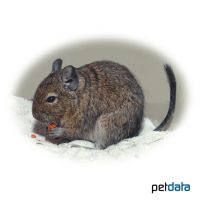Degu (Octodon degus)
| Degu Octodon degus | |
|---|---|
| Name | Degu |
| Name Lat. | Octodon degus |
| Family | Octodontids |
| Family lat. | Octodontidae |
| Order | Rodents |
| Order lat. | Rodentia |
| Origin | South America |
| Climate | Temperate |
| Habitat | Shrubland |
| Diet | Hay, seeds, green fodder |
| Behavior | Territorial |
| Keeping | Pair, group |
| Care Level | Moderate |
| Life Span | 3-5 years |
| Protection | No |
| Metric Units | |
| Size | 15 cm |
| Temperature | Room temperature |
| Housing | A: 0.5 m² / H: 1 m |
| US Units | |
| Size | 5.9" |
| Temperature | Room temperature |
| Housing | 5 ft² / 40" hight |
Distribution and habitat
The distribution area of the degus includes Bolivia, Argentina and Chile. They occur in coastal shrubland as well as in the high mountains up to 3,500 m altitude. They live in large colonies and retreat into their burrows in the evening or during the day when it is hot.
Maintenance
Minimum dimensions for the enclosure:
| 2-3 animals | area: 0.5 m² | height: 1 m |
| Each additional animal | Area: + 0,1 m² |
An enclosure that is placed in a bright (no direct sunlight), draft-free and quiet place is recommended, with side vents and it must not be tightly closed at the top. It should have varied structuring with larger stones, roots and branches and hiding and sheltering opportunities (rodent houses, tubes, clay caves, etc.) and platforms at different heights connected with ramps to expand the floor space. You will need food and drinking containers (water bottles), a sand bath (chinchilla sand) for grooming, nesting material (hay, straw, etc.) and a graveable substrate of commercial small animal litter or a sand and soil mixture covered with some bark mulch and dry leaves. The bedding depth should be at least 15 cm. Nail material, such as untreated twigs and branches from fruit trees, as well as a rodent stone, must always be available to wear down their teeth. They should be kept at room temperature and their natural day-night rhythm should be respected.
Diet
They are herbivores and require a diet rich in crude fiber. The species-specific food supply consists of high-quality forage hay, which must always be available in a hay rack. For this they need a mixture of low-fat seeds, available in specialized shops as "Degufutter", supplemented with green fodder (root vegetables, wild herbs, fresh grass panicles, zucchini, chicory, peppers, etc.) and fresh leafy twigs of birch, willow hazel bush or unsprayed fruit trees. Animal food (mealybug larvae, crickets, etc.) is hardly accepted, varying from individual to individual. Drinking water must always be available in hanging bottles or stable, open containers and, like food, must be offered fresh daily. Water and food containers must be placed in such a way that they cannot become soiled
A varied diet promotes health and prevents deficiency symptoms.
Behaviour and compatibility
Degus have a special need for harmony. However, even in a harmonious group, disputes can occur. When putting older animals together, tact is required, as they must gradually get used to each other. At the first signs of incompatibility, the animals should be separated immediately.
Reproduction and breeding
In sexually mature males, testes can be clearly seen and the distance between the anus and the urethral outlet is much smaller in the female.
They have an exceptionally long gestation period of about 85 days. A litter consists of an average of 5-6 fully hairy, walking and usually seeing young, which are independent after about 4 weeks. Females can become sexually mature after 6 weeks, males after three months. The life expectancy is about 3 years.
Important
Communication among themselves takes place via whistling and chirping sounds
If fed abundantly with sugary fruits and vegetables (e.g. apple, carrot), they may develop diabetes or cataracts.
It is recommended to provide variety by changing furnishings and occasionally rearranging them. Running wheels must be injury-proof, have a closed running surface and back wall and a diameter of at least 30 cm. As escape animals, they need sufficient retreat and hiding places, so the enclosure should also be somewhat elevated and not placed on the floor
They must not be grabbed or pulled by the tail, as the skin can easily tear and detach, resulting in the loss of the tail. Care should be taken to maintain thorough hygiene and contamination should be removed regularly. Further literature can be found in your pet store.
References
Text: petdata; Image: petdata
Source: KÜRSCHNER (2006): Mein Degu zu Hause, bede Verlag; W. PUSCHMANN, D. ZSCHEILE, K. ZSCHEILE (2009): Zootierhaltung - Tiere in menschlicher Obhut: Säugetiere, Harri Deutsch Verlag; BMEL (2014): Gutachten über Mindestanforderungen an die Haltung von Säugetieren
- Gemäß § 21 Abs. 5 Tierschutzgesetz idgF
